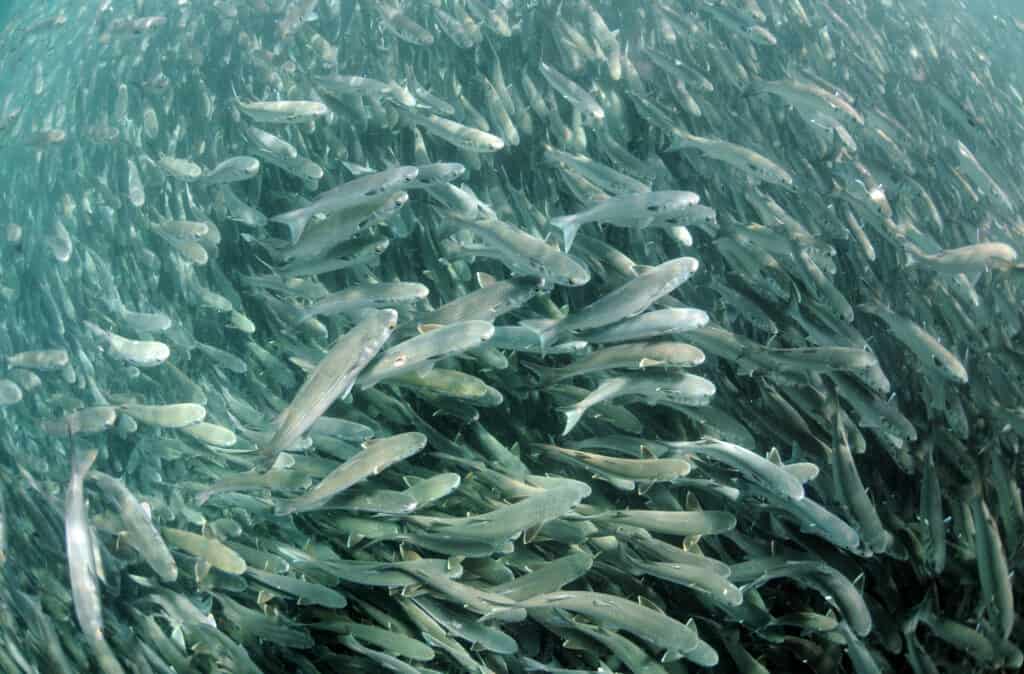Mullet Fish
Mugil cephalus
The Striped Mullet is one of the best-known and most easily identified species, with black horizontal stripes along its body.
Advertisement
Mullet Fish Scientific Classification
- Kingdom
- Animalia
- Phylum
- Chordata
- Class
- Actinopterygii
- Order
- Perciformes
- Family
- Mugilidae
- Scientific Name
- Mugil cephalus
Read our Complete Guide to Classification of Animals.
Mullet Fish Conservation Status
Mullet Fish Facts
- Prey
- algae, plant life, microorganisms
- Group Behavior
- School
- Fun Fact
- The Striped Mullet is one of the best-known and most easily identified species, with black horizontal stripes along its body.
- Biggest Threat
- Predators, including larger fish, birds of prey, and herons.
- Average Spawn Size
- 1- 7 million
- Habitat
- ocean, rivers and streams when spawning
- Predators
- Birds of prey, larger fish, herons
- Diet
- Herbivore
- Lifestyle
- School
- Favorite Food
- Algae
- Number Of Species
- 78
- Location
- Southern US, Caribbean Sea
View all of the Mullet Fish images!
Mullet Fish clean up the sea, feasting on small plant matter and other detritus in the water.
A popular fish for anglers, these fast-growing fish are common in warm, tropical waters. They like to swim near the surface and stay in schools when they go out to sea to spawn. Because they grow so quickly, they are plentiful and many people like to fish for them.
Mullet Fish Facts
- The Striped Mullet is one of the best-known and most easily identified species, with black horizontal stripes along its body.
- Mullet is a firm white flesh fish that can be grilled or fried.
- Mullet feed on small particles in the ocean, such as algae, bacteria, plant matter, and other microorganisms.
- Many other animals like to eat Mullet, including eagles and hawks, herons, as well as larger fish and dolphins.
- Mullet can live up to 13 years, although 5 to 7 is more common.
Classification and Scientific Name
Mullet Fish refers to all fish within the Mugilidae family of ray-finned fish. They are sometimes called Grey Mullets due to their coloring. The type species is the Flathead Grey Mullet or Mugil cephalus. There are around 78 species within the entire family, however. Many of them share the same characteristics and coloring.
Mugilidae is the only family within the Mugiliformes order. They are sometimes categorized in the Perciformes order instead. There is some debate among the scientific community as to the best way to organize and describe this family of fish. Either way, they belong to the Actinopterygii class. This includes all ray-finned fish whose fins are supported by bony rays rather than lobes. Mullets are part of the Chordata phylum and Animalia kingdom.
Mullet Fish Appearance
Mullet fish are silvery or grey in appearance, which is reflected in the common name of the family as well as the names of many of the species. They have thick, muscular bodies, which is one of the reasons that they are such a popular fish to catch. Mullets have two dorsal fins and small mouths. Their front dorsal fin has four spines or rays, placing them clearly in the company of other ray-finned fish in their class.
Because Mullet fish eat a lot of small plant matter in the ocean, they have a surprisingly complex digestive system to help them get the nutrients that they need from their food. Of course, this isn’t a feature that you can use to recognize a mullet while fishing.
Mullet can get between 1 and 3 feet long. The size depends on the exact species, how old it is, as well as where it was caught.

This large school of mullets close to the surface makes it easy to see why they are a favorite of fishers.
©FtLaud/Shutterstock.com
Distribution, Population, and Habitat
Mullets live in salt water or brackish water, most often in tropical areas. Some species are found off the coast of Florida. The Striped Mullet, Mugil cephalus, is often found in the warm water off the Florida coast. It is named the Striped Mullet because it has black stripes going horizontally on its body. This makes it easy to identify when caught. Striped Mullet in particular grow very quickly. Fishermen are encouraged to fish for Mullet and in some places, they are even cultivated as a game fish.
When they are young, juvenile Mullet live in smaller waterways such as rivers and streams that connect to the ocean, where they will spend their adult lives. As adults, they swim in schools, often near the surface of the water. Mullets also leap out of the water, often surprising anglers as well as other animals.
Mullets are an interesting part of the ecosystem. Because they feed on small plant matter and other detritus floating in their environment, they do the work of keeping it clean. Some scientists compare them to buffalo on the prairie. They grow bigger and when they are eaten, the food cycle continues.
Predators and Prey
Young Mullet fish are often just an inch long when they first start to swim. They make easy prey for larger fish. As they grow, they are still prey for larger fish, dolphins, birds of prey, herons, pelicans, and many other animals. They do not get very big compared to some other fish in the area and swim in schools near the surface, which make feeding easy.
When Mullet swim out to sea to spawn, many potential predators follow them. In the waters off the coast of Florida, these include king mackerel, Spanish mackerel, and sailfish.
If Mullets have so many predators, what do they count as potential prey? Mullet don’t actually eat other fish or animals. Instead, they feed on algae, plants, bacteria, and other microorganisms. This is why they are considered as grazers, cleaning up the water of their environment. They find plenty of food sources in the shallow water that they favor, near docks and jetties, as well as by coral reefs.
Reproduction and Lifespan
Mullet are known to swim out to sea to spawn. They don’t go far but stay in schools. The females lay between 1 and 7 million eggs when they spawn. They do not stay nearby, however, and most of these eggs are eaten by other fish or animals in the ocean. Of the ones that do hatch, they have the long and dangerous journey of getting to the safety of shallow water without being eaten. Fortunately for them, they can begin eating and growing right away.
Once they have hatched, the baby mullet swim to shallow water, often in rivers and streams, to develop. They eat the same thing as their parents, growing quickly into adult Mullet. These fish tend to live between 5 and 7 years. The oldest Mullet on record lived to be 13 years old.
Mullet in Fishing and Cooking
These are popular fish in fishing and cooking. They grow quickly, often stay near the surface, and are relatively easy to catch compared to some other ocean fish. They do not require specialized equipment because they do not get to be the massive size of some other tropical fish.
Mullet have strong, muscular bodies and make a firm filet. They are oily fish and have a stronger taste than some milder varieties. They grow quickly in the wild and do not accumulate mercury, unlike some other fish that live for many, many years.
One of the best ways to cook mullet is in a fish fry. Simply coat the fish with a binding agent and coating, then fry it in oil. This is an easy way to prepare mullet and you can season the fry to your individual taste and preferences. You can also grill Mullet because it will hold its shape well. It comes out tender and flaky when done well.
Similar Fish to Mullet
Goatfish: Also called a Red Mullet, these fish are not part of the Mullet family. Instead, they belong to the Mullidae. They are often brightly colored with forked tails and two barbels, or whiskers, on their face.
Flounder: When cooking, flounder makes a great substitute for Mullet. It is also a white, flaky fish that is firm enough for many of the same techniques and recipes.
View all 164 animals that start with MMullet Fish FAQs (Frequently Asked Questions)
How long to Grey Mullet live for?
Grey mullet can live up to 13 years, although most live between 5 and 7 years.
How big do Grey Mullet get?
Grey Mullet are typically between 1 and 3 feet long.
Is Grey Mullet healthy?
Mullet have plenty of Omega-3 fatty acids, as well as potassium, selenium, and Vitamin B6.
Thank you for reading! Have some feedback for us? Contact the AZ Animals editorial team.
Sources
- Britannica / Accessed September 21, 2022
- Florida Fish and Wildlife Conservation Commission / Accessed September 21, 2022
- TC Palm / Accessed September 21, 2022
- Texas Parks and Wildlife / Accessed September 21, 2022


















